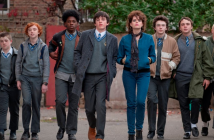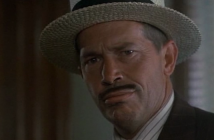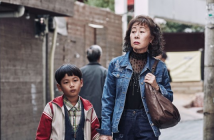
Editor’s Notes: Green Room is currently out in limited theatrical release.
Fearing for a character’s life is a feeling like no other, imbued with animalistic worry and a sense that you, the viewer, must come to grips with death’s grim reality right alongside them. But it’s not just a matter of character development or an immediately likable personality you’d hate to see gone, it’s generally about the creative lens capturing the deadly situation a film’s leads are involved in. What does the writing say about the events transpiring? Does the director show empathy or not, and if not, why? Are you being manipulated into your reactions at grotesque, intense sights, or are you feeling what you should (and were intended to) feel? Films, every now and then, answer these questions effortlessly, without words, before you can even ask them. Their craft instantly turns your knuckles white and the arms of your seat into devices for comfort beyond the physical, delivering a transcendent experience that leaves you manically obsessive when it’s over.
Of course it’s not that simple, so sinister intent leads to doubt, doubt leads to desperation, and a night of utter bloodshed begins.

As if foretold in a prophecy, director Jeremy Saulnier does all of this and more following up the critically-loved Blue Ruin with his new, equally praised backwoods thriller, Green Room. On top of being a brutally delivered adrenaline shot of animalistic fear, it’s the suspenseful story of punk rock band “The Ain’t Rights” who are struggling to find a gig on what seems to be the final leg of their casual tour. We can infer that interest has died down, enthusiasm has begun to dwindle, and reluctantly, the end is in sight. But with some effort, that gig they’re searching for finds itself in a shady bar, which they soon discover is hidden by trees and frequented (as well as run) by white supremacists. Their gig goes… some kind of way, greeted in equal measure by flying bottles and headbangs, but the return to their green room goes even worse when they’ve found themselves interrupting a fatal stabbing. After further events transpire, they’re barricaded in said green room while the owner of the bar (Patrick Stewart) stands outside the door, coaxing them to come out so all can be resolved. Of course it’s not that simple, so sinister intent leads to doubt, doubt leads to desperation, and a night of utter bloodshed begins.
Combine this thematic desperation with the very literal desperation of everyone wanting to survive the night, and what we watch in Green Room shakes us to our cores, deeply and endlessly.
We open rather quietly with the band waking up in their van, which has been inexplicably driven off the road into a cornfield the night prior. An explanation doesn’t seem important to them, however, when they discover the van’s out of gas and go off to get some, eventually stealing a hefty amount from another car. These people are on a journey, their own personal adventure, playing music (that they’ve made unavailable online) for anyone who wants to listen live and in-person. Diverging from that road, immobile and unable to move forward, sets them on a path straight back to the road by whatever means they deem necessary. This opening tells us exactly what we need to know: The Ain’t Rights are adamant to keep driving, keep playing, and don’t want to stop. But stopping is slowly becoming a harsh reality, and the beautiful memory of a wild audience is growing foggier. So, any venue will work for them, anywhere with people who’ll listen and enjoy. When they finally play their gig at the shady bar in the woods, all loud noises disappear, headed toward silence. Members of both the band and the audience dance across the frame in slow-motion, sheer euphoria can be seen and felt. Thus Green Room is not a morally black-and-white film, it’s not insistently pulpy or in love with the slaughter of an opposition. It knows that something human can be found in something so uninviting, and mirrors that throughout in any way it can.
Enter Patrick Stewart’s character and his cohorts, a group with an agenda, a journey of their own however unpleasant and fundamentally skewed it may be. It’s not just a personal journey to them, it’s the way they view their environment, feeling threatened and wanting to maintain power as long as they can by whatever means they deem necessary. That determination even defines the stabbing to which The Ain’t Rights, on their fateful visit to the bar, bear witness. The bar’s proprietors are afraid of stopping their operations, but when the brief 911 call the band has made reaches Stewart’s attention, the concept of stopping slowly becomes a harsh reality. His beautiful prospect of white supremacy, like the band’s memories of a wild audience, begins to fade. It’s by design that this response draws parallels to the reaction The Ain’t Rights display toward the dying of their tour; both parties have their own journeys, are afraid of reaching the ends, and will do whatever it takes to keep them going. They each want to go back to the way things were, but are in each other’s ways purely by circumstance, an inescapable truth only movable by brute force. Helplessness is the backbone of the film’s horror, as the band is simply trapped, and some unwilling affiliates of the owner find themselves somehow caught in the middle, navigating a backwoods labyrinth of shadows and paranoia. Combine this thematic desperation with the very literal desperation of everyone wanting to survive the night, and what we watch in Green Room shakes us to our cores, deeply and endlessly.
In the thick of the violence, death feels as if it’s a necessity for the performer and an inevitability for the victim. These two groups were bound to collide and, particularly in the climax, Saulnier paints scenes with an iconic sense of gargantuan scale that compliments how mythic this clash is written to be. Around every corner of the bar, at the end of every hallway, behind every door, is a deliverer of finality. An end for a life, an end for hope, an end for a journey. In fact, those corners, doors, and hallways are just as scary by themselves, captured in their ominous glory through gorgeous cinematography pervaded by green. The green isn’t used as a clever joke, mind you, but as a method of both establishing mood and letting each successive scene function as steps on one path, into darkness and out of it, never losing one absolute: Humanity, honest in its staggering extremes from the beautiful to the disturbing. This is wholly clear in a perfect final scene that brings all journeys to a close, resolutions forth, and truths into view while realities are walked away from, walked toward, and confronted. As a profound moment of poetic empathy plays out before the credits roll sixty seconds later, your heart aches for your own journey’s end yet feels relieved that you’ll finally be able to let out that breath you took an hour prior.
Does the phrase “this is one for the books” refer to an actual book? If so, we need to put in a chapter immediately for Green Room, one of the best films of the year and an absolute necessity to watch.
Does the phrase "this is one for the books" refer to an actual book? If so, we need to put in a chapter immediately for Green Room, one of the best films of the year and an absolute necessity to watch.



